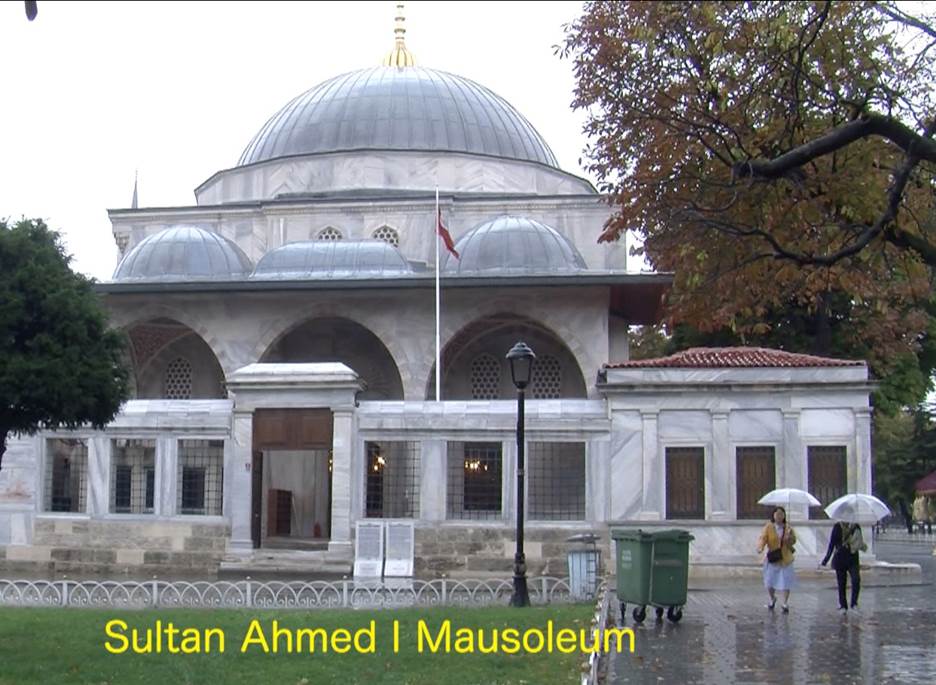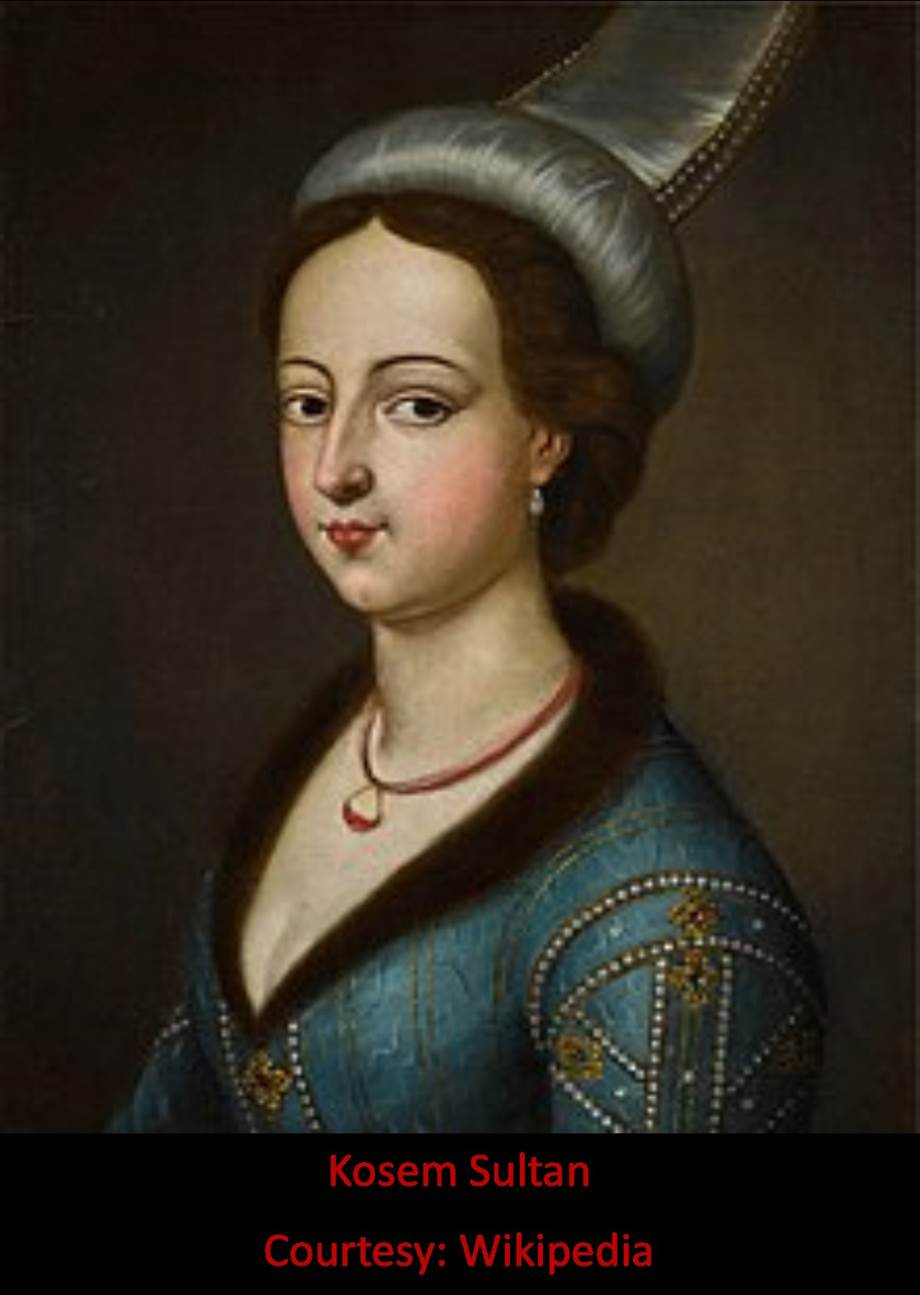
Kosem Sultan and the ‘Reign of the Ladies’ in Turkey
By Dr Khallid Siddiqui
Ohio

While six Queens had ruled England throughout history, there has not been a single female monarch in the Ottoman dynasty. However, there were several female chief consorts called Haseki ( خاصگی ) Sultans who wielded significant power. Some of these Haseki sultans later became sultan’s wives. One of them was Kosem Sultan. She was the most prominent figure during the 123-year-long ‘reign of the ladies’ – roughly from 1533 to 1656. She was Greek in origin but her name was changed to Mahpeyker ( ماہ پیکر )- meaning ‘the body of moon’ when she married the 14 th Ottoman Sultan, Ahmed I.

Sultan Ahmed I ascended the throne in 1603 at the age of 13 after the death of his father, Mehmed III. In keeping with the family tradition his father had all of his 19 half-brothers executed. They were strangled by his royal executioners. He also had seven pregnant concubines drowned. This action by his father had a profound impression on Ahmed I’s thinking, and he became the first sultan to put an end to the royal tradition of fratricide, i.e. execution of brothers upon accession to the throne. He is also credited with the construction of Sultan Ahmed Mosque, commonly known as The Blue Mosque. He promoted Kosem to Haseki status when she was only 15.
Kosem exerted considerable influence over Sultan Ahmed. Some manipulations and good luck allowed her to rise to the top of the Imperial Harem hierarchy at a young age. She was instrumental in changing the law of succession from primogeniture (first born legitimate son to inherit the throne) to agnatic seniority (sultan’s brothers to inherit the throne rather than the sons). Known for her ambitions and desire to direct the affairs of the state, the next two sultans (Mustafa I and Osman II) kept her away from the palace.
In 1623 her son Murad IV became the 17 th sultan at the age of 11 as, by then, all the brothers of Ahmed I had died. Kosem returned to the palace and ran the government as his regent.
After the death of Murad IV in 1640, another son of Kosem, Ibrahim (also known as Ibrahim the Mad), was put on the throne as the 18 th Sultan. As the sultan retreated from politics and spent most of his time in Harem, Kosem became politically active as his principal advisor. To keep him away from politics, she supplied him with virgins she personally purchased from the slave market. A war with Venice resulted in the blockade of Dardanelles by the Venetian Navy resulting in a decline in trade and substantial loss of revenue to the state. To continue his lavish lifestyle, the sultan imposed heavy taxes. He also expanded the Harem and, against tradition, promoted six concubines to the status of haseki ( خاصگی ) sultan. There was widespread discontent. Janissaries and Ulema also turned against him. His mother and Grand Vizier tried to depose him but they didn’t succeed. In retaliation, he executed the Grand Vizier and exiled his mother. The mob seized the sultan and imprisoned him in the palace.
His six-year old son, Mehmed IV, was put on the throne. Ibrahim refused to abdicate. A fatwa for his execution was obtained from Shaikh-ul-Islam, Abdurrahim Efendi, which was granted with the message: If there are two Caliphs, kill one of them. Kosem returned from exile and gave her consent. So, Ibrahim was strangled to death on August 18, 1648, while the mother watched it through the window. This was the second sultan who was strangled to death (regicide). The first one was Osman II who was strangled to death on May 16, 1622.
Mehmed IV, Kosem’s grandson, ascended the throne in 1648 at the age of six as the 19 th Ottoman Sultan. Traditionally, his mother Turhan Sultan should have been appointed as regent. Since Turhan Sultan was only 21 years old, it was decided to appoint a more experienced female regent. So, the grandmother Kosem was appointed as regent. She, once again, took control of the affairs of the state. Relationships between Turhan Sultan and Kosem Sultan deteriorated. Kosem Sultan decided to eliminate Turhan Sultan’s son and replace him with his younger half-brother, Suleiman. She allegedly gave two bottles of poisoned sherbet to the head helva (sweets) maker in the palace kitchen to be given to the child sultan, with the promise of promotion if he succeeded. The plot, however, was discovered. Kosem was charged as the instigator of the plot against the sultan, found guilty and sentenced to death. The Sultan summoned the mufti, who approved the death sentence. The child Sultan/Caliph signed the death warrant of her grandmother. She fought with her executioners gallantly but was ultimately strangled to death on September 2, 1651.
The Mausoleum of Sultan Ahmed I contains the tombs of Sultan Ahmed I, his wife Kosem and their son Sultan Murad IV. In addition to these three, there are numerous tombs of princes and princesses. I noticed, in all the mausoleums in Turkey, a disproportionately high number of small tombs, mostly with white turbans on top indicating the male occupant. My guide told me that these were the tombs of the children and young adults. The sultans had numerous children and many died in infancy. The reason for the male dominance is because many of those tombs are of the younger brothers of the new sultan who had ordered them to be strangled to death soon after assuming the throne.
Tucked between The Blue Mosque and Hagia Sophia, this small but beautiful mausoleum is missed by most tourists. It is worth visiting because there lies a powerful woman who ordered her own son to be strangled and, in turn, was ordered by her own grandson to be strangled to death.
Notes:
* The fratricide abolished by Sultan Ahmed I was soon reinstalled by his son Murad IV who had his brother Prince Bayazed strangled.
* All the ‘elective’ executions within the palace were ligature strangulation by a silk cord in order not to soil the expensive carpets by blood. The executioners were well-trained in that art.
* Regardless of their age and lifestyle, all the sultans starting from Selim I (also known as Yavez Selim or Selim the Grim) in 1517 to Abdulmejid II in 1934, were recognized as genuine Caliphs of the Sunni Islam all over the world. However, Abdulmejid II was only Caliph but not a Sultan. The Sultanate was abolished in 1924 and the last sultan, Mehmed VI (also known as Vahdettin or Wahid uddin) was exiled to Rome, Italy. The Turkey-based Caliphate was also abolished in 1934. Ataturk, however, offered the Caliphate to Ahmed Sharif as-Senussi for him to continue the Libya-based Caliphate, but Senussi declined.

